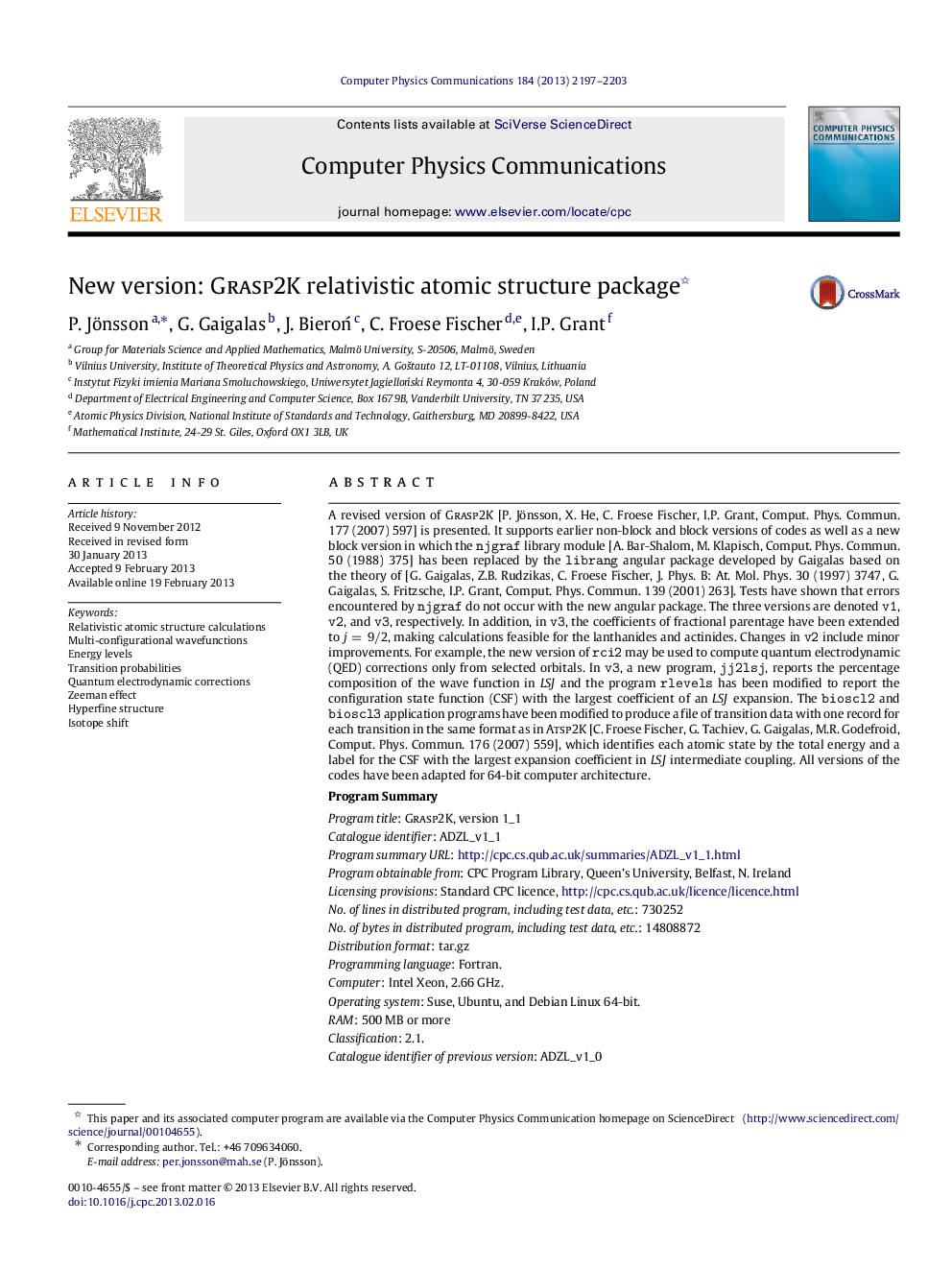| کد مقاله | کد نشریه | سال انتشار | مقاله انگلیسی | نسخه تمام متن |
|---|---|---|---|---|
| 502656 | 863714 | 2013 | 7 صفحه PDF | دانلود رایگان |

A revised version of Grasp2K [P. Jönsson, X. He, C. Froese Fischer, I.P. Grant, Comput. Phys. Commun. 177 (2007) 597] is presented. It supports earlier non-block and block versions of codes as well as a new block version in which the njgraf library module [A. Bar-Shalom, M. Klapisch, Comput. Phys. Commun. 50 (1988) 375] has been replaced by the librang angular package developed by Gaigalas based on the theory of [G. Gaigalas, Z.B. Rudzikas, C. Froese Fischer, J. Phys. B: At. Mol. Phys. 30 (1997) 3747, G. Gaigalas, S. Fritzsche, I.P. Grant, Comput. Phys. Commun. 139 (2001) 263]. Tests have shown that errors encountered by njgraf do not occur with the new angular package. The three versions are denoted v1, v2, and v3, respectively. In addition, in v3, the coefficients of fractional parentage have been extended to j=9/2j=9/2, making calculations feasible for the lanthanides and actinides. Changes in v2 include minor improvements. For example, the new version of rci2 may be used to compute quantum electrodynamic (QED) corrections only from selected orbitals. In v3, a new program, jj2lsj, reports the percentage composition of the wave function in LSJLSJ and the program rlevels has been modified to report the configuration state function (CSF) with the largest coefficient of an LSJLSJ expansion. The bioscl2 and bioscl3 application programs have been modified to produce a file of transition data with one record for each transition in the same format as in Atsp2K [C. Froese Fischer, G. Tachiev, G. Gaigalas, M.R. Godefroid, Comput. Phys. Commun. 176 (2007) 559], which identifies each atomic state by the total energy and a label for the CSF with the largest expansion coefficient in LSJLSJ intermediate coupling. All versions of the codes have been adapted for 64-bit computer architecture.Program SummaryProgram title: Grasp2K, version 1_1Catalogue identifier: ADZL_v1_1Program summary URL: http://cpc.cs.qub.ac.uk/summaries/ADZL_v1_1.htmlProgram obtainable from: CPC Program Library, Queen’s University, Belfast, N. IrelandLicensing provisions: Standard CPC licence, http://cpc.cs.qub.ac.uk/licence/licence.htmlNo. of lines in distributed program, including test data, etc.: 730252No. of bytes in distributed program, including test data, etc.: 14808872Distribution format: tar.gzProgramming language: Fortran.Computer: Intel Xeon, 2.66 GHz.Operating system: Suse, Ubuntu, and Debian Linux 64-bit.RAM: 500 MB or moreClassification: 2.1.Catalogue identifier of previous version: ADZL_v1_0Journal reference of previous version: Comput. Phys. Comm. 177 (2007) 597Does the new version supersede the previous version?: YesNature of problem : Prediction of atomic properties — atomic energy levels, oscillator strengths, radiative decay rates, hyperfine structure parameters, Landé gJgJ-factors, and specific mass shift parameters — using a multiconfiguration Dirac–Hartree–Fock approach.Solution method: The computational method is the same as in the previous Grasp2K [1] version except that for v3 codes the njgraf library module [2] for recoupling has been replaced by librang [3,4].Reasons for new version: New angular libraries with improved performance are available. Also methodology for transforming from jj- to LSJ-coupling has been developed.Summary of revisions : New angular libraries where the coefficients of fractional parentage have been extended to j=9/2j=9/2, making calculations feasible for the lanthanides and actinides. Inclusion of a new program jj2lsj, which reports the percentage composition of the wave function in LSJ. Transition programs have been modified to produce a file of transition data with one record for each transition in the same format as Atsp2K [C. Froese Fischer, G. Tachiev, G. Gaigalas and M.R. Godefroid, Comput. Phys. Commun. 176 (2007) 559], which identifies each atomic state by the total energy and a label for the CSF with the largest expansion coefficient in LSJ intermediate coupling. Updated to 64-bit architecture. A comprehensive user manual in pdf format for the program package has been added.Restrictions : The packing algorithm restricts the maximum number of orbitals to be ≤214≤214. The tables of reduced coefficients of fractional parentage used in this version are limited to subshells with j≤9/2j≤9/2 [5]; occupied subshells with j>9/2j>9/2 are, therefore, restricted to a maximum of two electrons. Some other parameters, such as the maximum number of subshells of a CSF outside a common set of closed shells are determined by a parameter.def file that can be modified prior to compile time.Unusual features: The bioscl3 program reports transition data in the same format as in Atsp2K [6], and the data processing program tables of the latter package can be used. The tables program takes a name.lsj file, usually a concatenated file of all the .lsj transition files for a given atom or ion, and finds the energy structure of the levels and the multiplet transition arrays. The tables posted at the website http://atoms.vuse.vanderbilt.edu are examples of tables produced by the tables program. With the extension of coefficients of fractional parentage to j=9/2j=9/2, calculations for the lanthanides and actinides become possible.Running time: CPU time required to execute test cases: 70.5 s.References: [1]P. Jönsson, X. He, C. Froese Fischer, I.P. Grant, Comput. Phys. Commun. 177 (2007) 597.[2]A. Bar-Shalom, M. Klapisch, Comput. Phys. Commun. 50 (1988) 375.[3]G. Gaigalas, Z.B. Rudzikas, C. Froese Fischer, J. Phys. B: At. Mol. Phys. 30 (1997) 3747.[4]G. Gaigalas, S. Fritzsche, I.P. Grant, Comput. Phys. Commun. 139 (2001) 263.[5]G. Gaigalas, S. Fritzsche, Z. Rudzikas, At. Data Nucl. Data Tables 76 (2000) 235.[6]C. Froese Fischer, G. Tachiev, G. Gaigalas, M.R. Godefroid, Comput. Phys. Commun. 176 (2007) 559.
Journal: Computer Physics Communications - Volume 184, Issue 9, September 2013, Pages 2197–2203